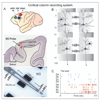Neural activity in frontal cortical cell layers: evidence for columnar sensorimotor processing
- PMID: 20695762
- PMCID: PMC3110724
- DOI: 10.1162/jocn.2010.21534
Neural activity in frontal cortical cell layers: evidence for columnar sensorimotor processing
Abstract
The mammalian frontal cortex (FCx) is at the top of the brain's sensorimotor hierarchy and includes cells in the supragranular Layer 2/3, which integrate convergent sensory information for transmission to infragranular Layer 5 cells to formulate motor system outputs that control behavioral responses. Functional interaction between these two layers of FCx was examined using custom-designed ceramic-based microelectrode arrays (MEAs) that allowed simultaneous recording of firing patterns of FCx neurons in Layer 2/3 and Layer 5 in nonhuman primates performing a simple go/no-go discrimination task. This unique recording arrangement showed differential encoding of task-related sensory events by cells in each layer with Layer 2/3 cells exhibiting larger firing peaks during presentation of go target and no-go target task images, whereas Layer 5 cells showed more activity during reward contingent motor responses in the task. Firing specificity to task-related events was further demonstrated by synchronized firing between pairs of cells in different layers that occupied the same vertically oriented "column" on the MEA. Pairs of cells in different layers recorded at adjacent "noncolumnar" orientations on the MEA did not show synchronized firing during the same task-related events. The results provide required evidence in support of previously suggested task-related sensorimotor processing in the FCx via functionally segregated minicolumns.
Figures










References
-
- Andersen RA, Buneo CA. Sensorimotor integration in posterior parietal cortex. Advances in Neurology. 2003;93:159–177. - PubMed
-
- Barbas H, Pandya DN. Architecture and frontal cortical connections of the premotor cortex (area 6) in the rhesus monkey. Journal of Comparative Neurology. 1987;256:211–228. - PubMed
-
- Barbas H, Pandya DN. Architecture and intrinsic connections of the prefrontal cortex in the rhesus monkey. Journal of Comparative Neurology. 1989;286:353–375. - PubMed
-
- Boussaoud D, Wise SP. Primate frontal cortex: Effects of stimulus and movement. Experimental Brain Research. 1993;95:28–40. - PubMed
-
- Burmeister JJ, Moxon K, Gerhardt GA. Ceramic-based multisite microelectrodes for electrochemical recordings. Analytical Chemistry. 2000;72:187–192. - PubMed
Publication types
MeSH terms
Grants and funding
LinkOut - more resources
Full Text Sources

